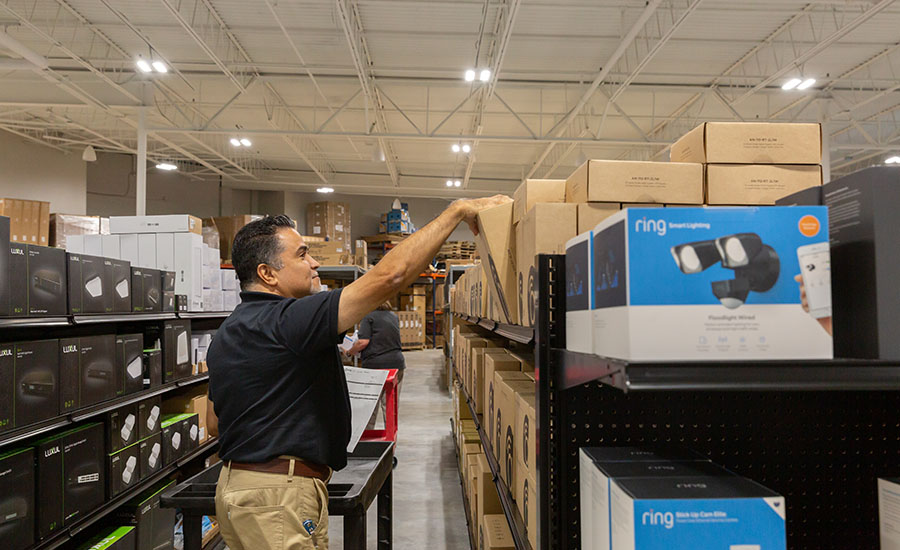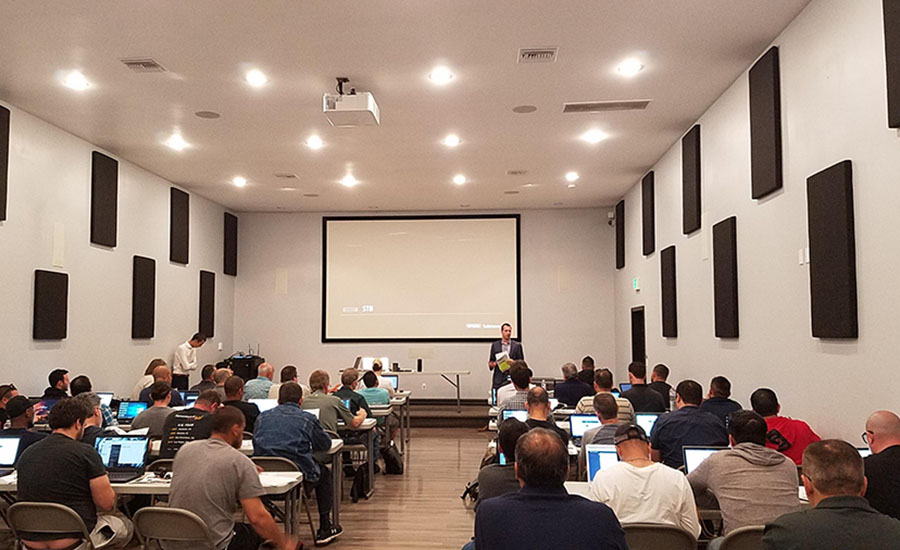When asked about the general outlook in the industry, security distribution professionals overwhelmingly agreed that the security landscape is nudging positive. That positive outlook, a welcome sentiment in the years following massive supply chain issues, pricing and inflation uncertainties and manufacturing shortages, will require persistent and patient tending, however, to surmount challenges.
Marco Cardazzi, senior vice president and chief marketing officer, ADI Global Distribution, Melville, N.Y., says the outlook on security distribution is trending positive across all categories including intrusion, video surveillance and access control, from his company’s perspective. “We’re experiencing strong pipelines, which is also being reinforced by feedback from our sales teams and supplier partners, and indicates growth and confidence in the market’s direction.”
Matt Barnette, president and CEO of PSA, Westminster, Colo., agrees, describing significant growth for PSA in the past three months. He notes, however, that they are hearing from PSA membership that some of the distribution companies in the market are becoming more aggressive, which may be an indication that they are seeing a slowdown in business. He adds, “Overall, we believe the future is bright for distribution businesses.”

A Changing Landscape
Barnette’s words reflect a sentiment voiced by others. Many of the opportunities present challenges that aren’t always easy to overcome. For instance, while customers, especially younger customers, are increasingly more comfortable with technology, they are also increasingly comfortable with DIY options. The resulting direct-to-customer brands that have emerged, though, often lack the professional installation and ongoing support that more complex integrated systems require, says Clint Choate, senior director of security markets, Snap One, Charlotte, N.C. “This increasing DIY demand alters our supply and demand planning.”
Then, while the industry was adjusting to those changes, COVID-19 burst onto the scene like an obnoxious uncle at a wedding. Out of adversity, however, came needed correction and flexibility. “Our sourcing and logistic approaches were stressed during COVID; they were forced to adjust and evolved to be more flexible,” Choate explains. This stress helped Snap One learn to handle the difficulties of the current environment. Choate says the stress has helped them navigate intermittent shortages and roadblocks. “While challenges like chip shortages continue to pop up, the overall trend is positive for distributors who can offer innovative solutions and strong support for integrators.” (See Sidebar “Who’s Bringing the Chips?”)
Added to customers’ increasing tech savviness is a growing awareness of the need for robust security systems, says Dennis Holzer, executive director, PowerHouse Alliance, Pittsburgh. “As security becomes a higher priority, consumers are more willing to invest in advanced solutions,” he explains. “The proliferation of smart home devices and the integration of security systems with home automation technology are driving market growth. Consumers increasingly seek seamless solutions that offer both convenience and security.”
As mentioned, however, with each opportunity comes challenges. Customers want seamless integration of technology, but with a heavier reliance on Wi-Fi and with more customers eliminating traditional phone lines, reliability becomes an issue. Additionally, Holzer adds, “Different systems often have distinct objectives and compatibility issues, making seamless integration difficult.”
Continuous technological advancements provide the raw material for the lemonade of opportunity and growth, though. “DIY security options have raised awareness of smart home and security solutions, increasing adoption and market penetration,” Cardazzi says. He describes DIY as gateway products for homeowners who wouldn’t typically be interested in a traditional security system, creating new opportunities for security dealers to upsell customers on comprehensive security and smart home solutions. “For example,” he says, “video doorbells continue to be popular among consumers and often lead to a professionally installed solution that offer higher end feature sets.”
Overall, we believe the future is bright for distribution businesses.
False Inflation & Artificial Revenue Bumps
With the increasing and evolving technology come other challenges that might be mistakenly chalked up to inflation, especially with the inflation across the economy over the past several years. Holzer points out, however, that price increases are often a result of a changing technological landscape, not necessarily a changing economical one only. He explains, “As more data, especially surveillance video, is transmitted, costs increase. The expense for installers handling this data has risen, typically from $8-$12 per line, but consumers may face costs up to $70 per month. This is not traditional inflation but rather a consequence of higher data transmission requirements.”
Another effect price increases and inflation have is giving companies’ revenue an artificial bump and a false sense of growth. These technology-related price increases, when passed on to the customer, bump companies’ revenue, making companies believe they are growing, although Barnette describes this growth as artificial. Holzer adds, “With more video and data being sent through lines, costs naturally rise. While this isn’t conventional inflation, it results in higher consumer prices.” He hopes that future technological advancements and improved data efficiency will reduce these costs. Meanwhile, Barnette says, “Inflation is slowly eating away at a lot of companies as they are hesitant to increase pricing, especially of labor, which is eroding margins and profitability of most integrators.”
Overall, however, pricing has settled down. Barnette describes pricing during the supply chain crisis as “out of control.” He explains, “We were getting weekly updates/increases from some companies and even had a few that tried to retroactively increase prices on orders that were already on the books.” While most of this has returned to normal, he says they are still hearing about component price increases, especially copper, that he says will have an impact for most products.
We asked several professionals to describe what their organizations were doing to help integrators navigate the challenges they are facing and thrive.
Marco Cardazzi, ADI Global Distribution: “ADI offers numerous learning opportunities throughout the year to help customers learn about the newest products, navigate industry trends and challenges, enhance business skills, and earn CEUs. Those opportunities include training in ADI branches, at the ADI Expo Series events, in online webinars, or through ADI’s on-demand training platform.”
Clint Choate, Snap One: “We support integrators by providing technical training and certification programs. These programs equip integrators with the skills needed for advanced security systems, allowing them to upskill their existing workforce and attract new talent. Furthermore, Snap One offers ongoing technical support throughout a project’s lifecycle, including pre-sales consultations, troubleshooting assistance, and access to valuable technical resources.”
Matt Barnette, PSA: “We offer monthly committee meetings for different functional areas of an integration business where the integrators themselves share knowledge in a moderated peer-to-peer environment. We also put together world-class education at our two large annual events, PSA TEC and PSA Convention, plus the work we do at other industry events like ISC East and ISC West. We have a learning management system, PSA University, to help integrators educate their people; we provide technology leadership with our business solutions providers who help integrators with products and services to help run their businesses more efficiently and we have partnered with third parties to provide sales, managed services and other types of services.”
Dennis Holzer, PowerHouse Alliance: “At PowerHouse, we are dedicated to supporting our integrators through several initiatives. We offer extensive training sessions to keep integrators updated on the latest technologies and best practices. Our members also provide ongoing technical assistance to help with complex installations and troubleshooting. We also assist integrators in understanding and implementing the latest integration solutions, ensuring their systems work seamlessly with other smart home technologies.”
Meeting the Challenge Head On
Cardazzi agrees that, while supply chain issues have been ameliorated significantly, many challenges remain. “Supply chain disruptions still remain a concern. Some of these include the impacts from the Red Sea crisis, logistics concerns, cost of raw materials and component shortages, and freight costs.”
Cardazzi says ADI is meeting the issues head on by working closely with both its supplier partners and its integrator customers to ensure it has proper inventory levels. “Through our integrated business planning process, our demand planning team collaborates with suppliers to understand their current inventory, secondary and tertiary component sourcing, and levels of production so that we can respond with additional safety stock or order expedites when necessary. In addition, we collaborate closely with our logistics partners to improve operational efficiencies and develop robust contingency plans aimed at minimizing supply chain disruptions.”

Worker Shortage — A Thorn in the Industry’s Side
One challenge that increased technology may not eliminate but could help mitigate is the persistent workforce shortage. Cardazzi contrasts the growing demand for security solutions and services with the shrinking availability of skilled personnel to meet these needs. “Companies need to focus on workplace culture, employee recruiting and retention strategies, while also investing in training for their employees,” Cardazzi says.
Barnette calls labor shortage the No. 1 issue for integrators and doesn’t see that changing in the near future, adding that integrators often cannot find enough skilled labor to handle the work they have on the books.
Yes, the chip shortage is still a problem, although it’s not as dismal as it was just a year or two ago. Although there are no immediate fixes, solutions are in the works.
Clint Choate of Snap One shares observations regarding the once dire supply chain disruption. “While many of the supply chain disruptions caused by COVID have been resolved or mitigated, the global chip shortage remains a significant hurdle,” he says.
This chip shortage is a result of several factors, including an increased demand for electronics during COVID, geopolitical tensions and disruptions in certain regions, as well as things previously mentioned, such as the ramping up of technology across industries, not just the security industry. “Despite these challenges there are reasons for optimism,” Choate says. “Chip manufacturers are actively ramping up production to meet demand. Additionally, efforts are underway to diversify chip manufacturing across different regions, reducing reliance on any single source. This diversification will take time to fully implement, but it represents a long-term solution to chip shortages.”
In the meantime, Choate advises, security product distributors need to adapt by building strong relationships with manufacturers. This close collaboration will allow for better forecasting of chip availability and allocation of resources. Furthermore, exploring alternative sourcing options for certain components can help distributors avoid being overly reliant on a single supplier.
“By remaining agile and adopting these strategies, we can navigate the ongoing chip shortage and continue delivering the essential products that integrators need to keep their customers safe,” Choate says.
While the workforce shortage presents a challenge for distributors and integrators, there are solutions, Choate says. “Increased collaboration can optimize workflows, share resources and even allow for cross-training staff to improve efficiency. Industry associations play a crucial role in promoting security and technician careers to attract new talent. Additionally, investing in training programs for existing employees and creating clear paths for career advancement can boost retention.”
Holzer laments that fewer young people are entering the field. “The lack of formal education and training exacerbates this problem,” he says. He points to trades such as plumbing and electrical work that have established pathways to certification and formal trade schools. “The AV and security sectors need more structured educational opportunities.” PowerHouse Alliance, he says, is actively collaborating with trade schools to develop courses that address this gap.
Companies need to focus on workplace culture, employee recruiting and retention strategies, while also investing in training for their employees.
“Building Talent Foundation and Foundation for Advancing Security Talent are doing great work to help bring new skilled workers to the industry,” Cardazzi says. “ADI provides annual support to various scholarship funds to help recruit skilled workers into the industry.”
Advancing technology also offers reason for optimism, Barnette describes. “Using technology instead of rolling trucks is just one area that needs significant investment to provide better support without consuming resources.”
As an industry based upon offering security, reliability and certainty in a world filled with uncertainty, failing to overcome the challenges is not an option. Security distributors and their associations can and must continue to be agile in a quickly changing world.







